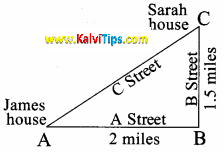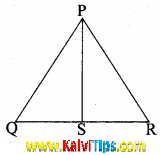Tamil Nadu Board 10th Standard Maths - Chapter 4 Unit Exercise 4.3: Book Back Answers and Solutions
This post covers the book back answers and solutions for Chapter 4 Unit Exercise 4.3 – Maths from the Tamil Nadu State Board 10th Standard textbook. These detailed answers have been carefully prepared by our expert teachers at KalviTips.com.
We have explained each answer in a simple, easy-to-understand format, highlighting important points step by step under the relevant subtopics. Students are advised to read and memorize these subtopics thoroughly. Once you understand the main concepts, you’ll be able to connect other related points with real-life examples and confidently present them in your tests and exams.
By going through this material, you’ll gain a strong understanding of Chapter 4 Unit Exercise 4.3 along with the corresponding book back questions and answers (PDF format).
Question Types Covered:
- 1 Mark Questions: Choose the correct answer, Fill in the blanks, Identify the correct statement, Match the following
- 2 Mark Questions: Answer briefly
- 3, 4, and 5 Mark Questions: Answer in detail
All answers are presented in a clear and student-friendly manner, focusing on key points to help you score full marks.
All the best, Class 10 students! Prepare well and aim for top scores. Thank you!
Chapter 4 Algebra Unit Ex 4.3
Answer Key:
Let the initial position of the man be “O” and his final
position be “B”.
By Pythagoras theorem
In the right ∆ OAB,

= 182 + 242
= 324 + 576 = 900
OB = = 30
The distance of his current position is 30 m

Distance between Sarah House and James House using “C street”.
AC2 = AB2 + BC2
= 22 + 1.52
= 4 + 2.25 = 6.25
AC =
AC = 2.5 miles

= (2 + 1.5) miles = 3.5 miles
Difference in distance = 3.5 miles – 2.5 miles = 1 mile
Answer Key:
In the right ∆ABC,
By Pythagoras theorem
AC2= AB2 + BC2 = 342 + 412
= 1156 + 1681 = 2837
AC =
= 53.26 m

The difference in Distance = 75 – 53.26
= 21.74 m
Calculate the length and breadth of the rectangle?

Let the length of the rectangle be “a” and the breadth of the rectangle be “b”.
XY + YZ = 17 cm
b + a = 17 …….. (1)
In the right ∆ WXZ,
XZ2 = WX2 + WZ2
(XZ)2 = a2 + b2

Similarly WY = ⇒ XZ + WY = 26
2 = 26 ⇒ = 13
Squaring on both sides
a2 + b2 = 169
(a + b)2 – 2ab = 169
172 – 2ab = 169 ⇒ 289 – 169 = 2 ab
120 = 2 ab ⇒ ∴ ab = 60
a = ….. (2)
Substituting the value of a = in (1)
+ b = 17
b2 – 17b + 60 = 0
(b – 2) (b – 5) = 0
b = 12 or b = 5
.png)
If b = 6 ⇒ a = 12
Lenght = 12 m and breadth = 5 m
Answer Key:
Let the shortest side of the right ∆ be x.
∴ Hypotenuse = 6 + 2x
Third side = 2x + 6 – 2
= 2x + 4

AC2 = AB2 + BC2
(2x + 6)2 = x2 + (2x + 4)2
4x2 + 36 + 24x = x2 + 4x2 + 16 + 16x
0 = x2 – 24x + 16x – 36 + 16
∴ x2 – 8x – 20 = 0
(x – 10) (x + 2) = 0
x – 10 = 0 or x + 2 = 0
.png)
The side AB = 10 m
The side BC = 2 (10) + 4 = 24 m
Hypotenuse AC = 2(10) + 6 = 26 m
Answer Key:
“C” is the position of the foot of the ladder “A” is the position of the top of the ladder.
In the right ∆ABC,
BC2 = AC2 – AB2 = 52 – 42
= 25 – 16 = 9
BC = = 3m.
When the foot of the ladder moved 1.6 m toward the wall.
The distance between the foot of the ladder to the ground is
BE = 3 – 1.6 m
= 1.4 m

The ladder touch the wall at (4 + h) M
In the right triangle BED,
ED2 = AB2 + BE2
52 = (4 + h)2 + (1.4)2
25 – 1.96= (4 + h)2
∴ 4 + h =
4 + h = 4. 8 m
h = 4.8 – 4
= 0.8 m
Distance moved upward on the wall = 0.8 m
Answer Key:
Given QS = 3SR
QR = QS + SR
= 3SR + SR = 4SR
SR = QR …..(1)
QS = 3SR
SR = ……..(2)

QR =
∴ QS = QR ………(3)
In the right ∆ PQS,
PQ2 = PS2 + QS2 ……….(4)
Similarly in ∆ PSR
PR2 = PS2 + SR2 ………..(5)
Subtract (4) and (5)
PQ2 – PR2 = PS2 + QS2 – PS2 – SR2
= QS2 – SR2
.png)
2PQ2 – 2PR2 = QR2
2PQ2 = 2PR2 + QR2
Hence the proved.
Answer Key:
Since the Points D, E trisect BC.
BD = DE = CE
Let BD = DE = CE = x
BE = 2x and BC = 3x

AD2 = AB2 + BD2
AD2 = AB2 + x2 ……….(1)
In the right ∆ABE,
AE2 = AB2 + 2BE2
AE2 = AB2 + 4X2 ………..(2) (BE = 2x)
In the right ∆ABC
AC2 = AB2 + BC2
AC2 = AB2 + 9x2 …………… (3) (BC = 3x)
R.H.S = 3AC2 + 5AD2
= 3[AB2 + 9x2] + 5 [AB2 + x2] [From (1) and (3)]
= 3AB2 + 27x2 + 5AB2 + 5x2
= 8AB2 + 32x2
= 8 (AB2 + 4 x2)
= 8AE2 [From (2)]
= R.H.S.
∴ 8AE2 = 3AC2 + 5AD2









0 Comments:
Post a Comment